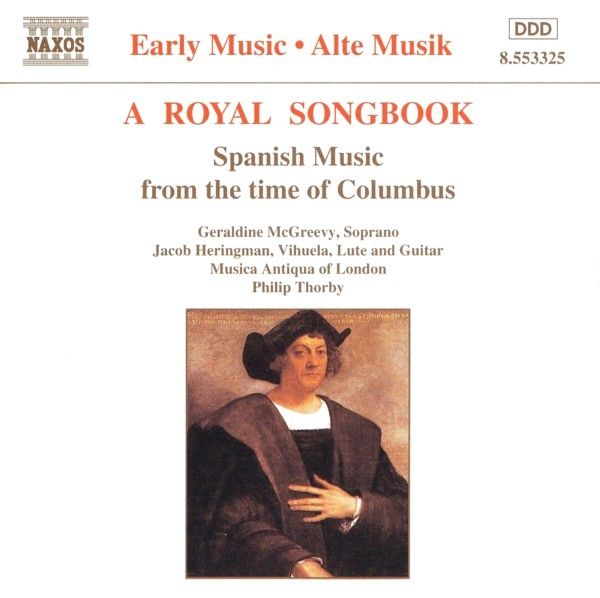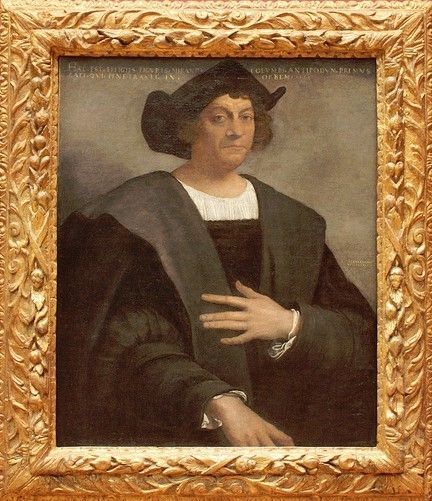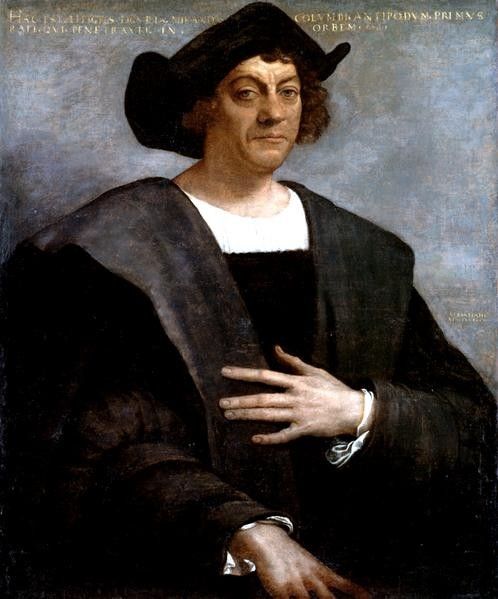A Royal Songbook / Musica Antiqua of London
Spanish Music from the time of Columbus

medieval.org
Naxos 8.553325
1995
Cancionero Musical de Palacio
except Alonso Mudarra & Diego Ortiz
1. Calabaça [2:14]
2. Ay Santa María [2:42]
3. Pedro de ESCOBAR (c.1465-1535). Virgen bendita sin par
[3:36]
4. Juan de ANCHIETA (1462-1523). Con amores mi madre
[2:49]
5. GARCIMUÑÓS. Pues bien para esta [3:48]
6. Passamezzo [1:22]
7. Alonso MUDARRA (c.1510-1580). Pavana
d'Alexandre, Gallarda [2:30]
Tres Libros de Musica en Cifra para Vihuela
8. Tres morillas - FERNANDEZ. Tres moricas
[2:35]
9. GABRIEL. Aquella mora garrida [4:17]
10. Dentro en el vergel [1:15]
11. Johannes OCKEGHEM (c.1410-1497). De la momera [1:39]
(S'elle m'amera / Petite camusette)
12. Juan del ENCINA (1468-1530). Amor con fortuna [1:05]
13. Juan PONÇE (c.1480-1521). Como está sola mi vida
[2:21]
14. ROMÁN. O voy [2:06]
15. La Gamba [1:31]
16. Diego ORTIZ (c.1510-1570). Recercada
quarta [1:27]
Tratado de Glosas
17. LUCHAS. A la caça [1:52]
18. Alonso MUDARRA. Guárdame
las vacas [1:17]
Tres Libros de Musica en Cifra para Vihuela
19. Niña y viña [1:36]
20. Francisco de la TORRE. Danza alta [1:52]
21. Diego ORTIZ. Recercada tercera
[3:02]
Tratado de Glosas
Alonso MUDARRA
22. Si me llaman, a mí llaman [1:52]
23. Isabel, perdiste la tu faxa [1:16]
24. Fantasía que contrahaze la harpa en la manera de Luduvico
[2:22]
Tres Libros de Musica en Cifra para Vihuela
25. A la mia gran pena forte [2:46]
26. Dios te salve [3:04]
27. Ya somos del todo libres [2:22]
28. VILCHES. Ya cantan los gallos [4:33]
29. Dindirindín [1:38]
30. Juan del ENCINA. Cucú [1:14]
Geraldine McGreevy, soprano
Harvey Brough, tenor
Jacob Heringman, vihuela, lute, guitar
Musica Antiqua of London
Philip Thorby
Recording at St.
Martin's Church, East Woodhay, Hampshire
from 5th to 7th March 1995
Producer & Engineer: John Taylor

A ROYAL SONGBOOK
Spanish Music from the time of Columbus
Musical Sources
The marriage in 1469 of Ferdinand of Aragon to Isabella of Castile
brought the whole of the Spanish peninsula, with the exception of
Portugal, under direct rule from Madrid. With the end of the long wars
between Aragon and Castile came a flowering of Spanish nationalism,
religious fervour and culture. Nationalism resulted in 1492 in the
expulsion of the Moors from Spain, religious revival led to the
establishment of the Holy Inquisition; and one of the most vivid
illustrations of the flowering of the arts under the 'Catholic
Monarchs' is the Cancionero Musical de Palacio — the
Palace Song Book. A vast collection of songs composed between about
1440 and 1515, the manuscript was compiled at the Spanish court in
stages from 1500 to 1520. The practice of collecting an entire
repertoire, as an expression of pride in the music, and possibly a
desire to preserve it for posterity, dates from medieval times.
The Song Book is the source for most of the music in the
present recording, but two later printed collections have also been
consulted. Tres Libros de Musica en Cifra para Vihuela by
Alonso Mudarra (Seville, 1546) contains not just music intabulated for
the vihuela, but also solos for the guitar, and vihuela-songs. Mudarra,
a liberal-minded canon at Seville Cathedral is arguably the most
musically rewarding of the vihuelistas, and all the vihuela, lute and
guitar music on this recording is by him.
The other publication from which we have taken music is Tratado de
Glosas by Diego Ortiz (Rome 1553). A treatise on the art of
improvising music either unaccompanied or based on existing songs or
dances, the Tratado is written in terms of the viol, on which
Ortiz was a famous virtuoso. At the end of the book Ortiz gives
examples of most of the types of improvisation, thus leaving some of
the earliest surviving solo music for the viol.
These two publications, while produced later than the Palace Song
Book, are particularly relevant to any programme of Spanish
renaissance music, because of the instruments for which they are
written. The vihuela is essentially a guitar-shaped lute,
unique to sixteenth-century Spain, while the little renaissance guitar
was eventually to grow into that country's national instrument. The
viol surely the most important ensemble instrument of the Renaissance,
seems to have been born in Spain (sharing its parentage with the
vihuela), travelling later to Italy and Northern Europe.
Perhaps the most striking feature of the Palace Song Book is
the sheer variety displayed in its 463 pieces. The earliest songs are
in the medieval courtly love tradition: but late texts range from the
earthiest sexual innuendo, through artfully simple pseudo-folk-songs,
to sacred songs of passionate devotion.
Our recording reflects this range. The crude phallic symbolism of Calabaça
[1], with its ironic (even sacrilegious) reference to the Virgin Mary,
is followed directly by two pieces inspired by fervent Marian texts [2
and 3]. Ay Santa Maria first occurs in the earlier Colombina
manuscript in a version which lacks the haunting simplicity of this Palace
Song Book version. Whilst in Virgen bendita sin par Escobar
makes use of a melody which appears elsewhere in the Song Book with a
simple pastoral text. The melody is here transformed both by the text
and by Escobar's subtle harmonies into an extended sacred dance-song of
luminous beauty.
Love Songs
As one might expect, most of the songs in the Palace Song Book
are love-songs: but here again there is variety. A number of texts take
the form of a daughter confiding to her mother about her lover, a genre
peculiar to this repertoire. In Con amores [4], for example,
the girl recounts (in a suitably sleepy quintuple metre) her dream of
love; by contrast Pues bien para ésta begins in the
middle of a heated argument between the daughter, who is desperate to
marry, and her mother, who wants her to wait. (The daughter, by an
outrageous combination of threats and emotional blackmail, gets her
way.)
Another type of Spanish love-song deals with the Moorish lover, male or
female. In the delightful miniature Tres Morillas [8] the poet
is haunted by the memory of Axa, Fatima and Marien, three Moorish girls
in Jaen. Aquella mora garrida is a more complex poetical
conceit: the text is sung by a girl who has been carried off by Moors,
but the refrain is a folk-song sung by a man ("That lovely Moorish
girl, her love brings pain to my life"). Both poet and composer handle
this double perspective with great skill.
A more conventional vein of love-song is Como está [13]
in which the singer laments the departure of her lover.
Pastoral Texts
One strand in the Palace Song Book which is parallelled in other
contemporary collections is the pseudo-rustic element. In England Henry
VIII and his court played at hunters and foresters in May-Day
festivities; in France and Italy too there is a substantial pastoral
repertoire. So it comes as no surprise to find pieces such as A la
caça [17], a glorious evocation of the hunt of love, or Niña
y Viña [19], where a country girl recounts (to her mother!)
how she was seduced by a vineyard keeper. The instrumental Guárdame
las vacas [18] is a setting for solo guitar of a song supposedly
sung by a seductive cow-girl. Rural imagery crops up throughout the
repertoire, from pumpkins [1] to birds [28, 29, 30].
Problem Texts
Throughout the vocal repertoire of the early renaissance there occur
songs whose texts are short and enigmatic. In such pieces it is not
always possible to tell whether what survives is a single strophe from
a longer work, or whether today we simply miss references and
resonances which would have fleshed out the texts for a contemporary
listener. Spanish collections include many works of this type: the
apparently inconsequential words of the vihuela-songs Isabel
and Si me llaman [22, 23] are at odds with the contrapuntal
elegance of Mudarra's music, but the very quality of the vihuelist's
elaborate settings serves to colour in the sketchy images of the verse.
Instrumental Performance
One way to avoid the problems posed by an apparently incomplete text is
to perform such a work instrumentally. Vocal music formed the core of
instrumental repertoire in the Renaissance, performed with no
ornamentation (for example Amor con fortuna [12]), with
decoration shared between the parts (for example Dentro en el vergel
[10] and De la momera [11]) or with one voice used as a vehicle
for elaborate improvised divisions in the manner described by Diego
Ortiz (for example Dios te salve [26]).
Instrumental virtuosi borrowed not only songs but also dances as a
basis for their repertoire: the galliard La gamba [15] and the
saltarello Alta [20] were both taken as the starting-point for
imaginative divisions by Diego Ortiz [16 & 21]. In the case of the Passamezzo
[6] it is Alonso Mudarra who transforms the simple chord sequence into
the graceful Pavana d'Alexandre for solo guitar [7].
Indeed composers such as Mudarra gave us some of the earliest music for
specified instruments. The tablature in which the lute, vihuela and
guitar repertoire was written largely defines the instrument for which
it was intended. The most substantial such piece on this recording [24]
is a homage to the blind harp virtuoso Luduvico: the Fantasia 'in the
manner of Luduvico' paints an exhilarating picture of an improvising
virtuoso. Much of the colour is given by notes which, explains Mudarra,
will at first sound like false notes, but which must be played with
conviction.
Sacred and Profane
Our recording ends as it began, with two groups of contrasted pieces. A
la mía [25] and Ya somos del todo libres [27] set
texts dealing with the Crucifixion; the first in the voice of Christ
foretelling his fate (with its refrain "they will divide my clothes and
cast lots for them"), the second celebrating man's release from death
"and from the power of accursed Lucifer". Between these pieces is De La
Torre's hymn to the Cross Dios te Salve [26], here
instrumentally performed.
The final group, by contrast, returns to the world of rustic imagery,
with three songs about birds. In Ya cantan los gallos [28] the
crowing of the cock awakens a pair of young lovers, she afraid of
scandal should they be discovered, he prepared to risk anything for
love. There is a sting in the tail of Dindirin [29], though it
begins innocently enough: a girl meets a nightingale, and prettily asks
it to take a message to her lover — but the message is that she
has got married. And with Cucú [30] we return to the
earthy mood of Calabaça [1]: a
tongue—in—cheek evocation of the song of the cuckoo
repeatedly gives way to a reminder of its less welcome significance as
the unwelcome symbol of the cuckold!
© 1995 Philip Thorby



